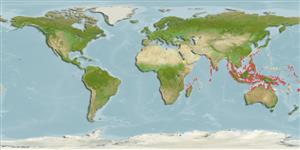Common names from other countries
Teleostei (teleosts) >
Gobiiformes (Gobies) >
Gobiidae (Gobies) > Gobiinae
Etymology: Exyrias: Derived from Greek, xyreo = to shave (Ref. 45335).
More on author: Bleeker.
Environment: milieu / climate zone / depth range / distribution range
Ecology
Marine; brackish; reef-associated; depth range 0 - 5 m (Ref. 90102). Tropical; 23°C - 28°C (Ref. 13614); 35°N - 20°S
Western Pacific: Andaman Islands to Vanuatu, north to Japan, south to New Caledonia. Occurs in the Mekong delta, but possibly may be found as far upstream as the tidal zone (Ref. 12693).
Size / Weight / Age
Maturity: Lm ? range ? - ? cm
Max length : 16.2 cm TL male/unsexed; (Ref. 11344)
Dorsal spines (total): 7; Dorsal soft rays (total): 10 - 11; Anal spines: 1; Anal soft rays: 9 - 10; Vertebrae: 26. Ground color brown, darker dorsally; dusky spots proximally on pectoral fin; blackish pelvic fins. 10 or more predorsal scales. Cheeks and opercula fully scaled. Spines of 1st dorsal fin elongated into filaments. Differs from E. belissimus by having fewer predorsal scales and slightly different details of coloration (Ref. 1602); characterized further by having pectoral rays 16-18; rounded caudal fin; longitudinal scale series 30-33; ctenoid scales except cycloid on nape and isthmus; depth of body 3.6-4.0 in SL (Ref. 90102).
Solitary or in groups (Ref. 90102). Inhabits muddy bottoms of shallow, turbid marine to brackish coastal inlets and estuaries. Also lives in shallow coastal waters, large tidal pools, mangroves, siltty lagoons and brackish lakes (Ref. 48637).
Life cycle and mating behavior
Maturities | Reproduction | Spawnings | Egg(s) | Fecundities | Larvae
Murdy, E.O., 1985. A review of the gobiid fish genera Exyrias and Macrodontogobius, with description of a new species of Exyrias. Indo-Pac. Fish. (10):14 p. (Ref. 403)
IUCN Red List Status (Ref. 130435)
CITES (Ref. 128078)
Not Evaluated
Threat to humans
Harmless
Human uses
Fisheries: commercial; aquarium: commercial
Tools
Special reports
Download XML
Internet sources
Estimates based on models
Preferred temperature (Ref.
115969): 26.2 - 29.3, mean 28.7 (based on 2386 cells).
Phylogenetic diversity index (Ref.
82804): PD
50 = 0.5312 [Uniqueness, from 0.5 = low to 2.0 = high].
Bayesian length-weight: a=0.01023 (0.00477 - 0.02194), b=3.02 (2.84 - 3.20), in cm Total Length, based on LWR estimates for this (Sub)family-body shape (Ref.
93245).
Trophic level (Ref.
69278): 3.5 ±0.37 se; based on food items.
Resilience (Ref.
120179): High, minimum population doubling time less than 15 months (Preliminary K or Fecundity.).
Fishing Vulnerability (Ref.
59153): Low vulnerability (10 of 100).
